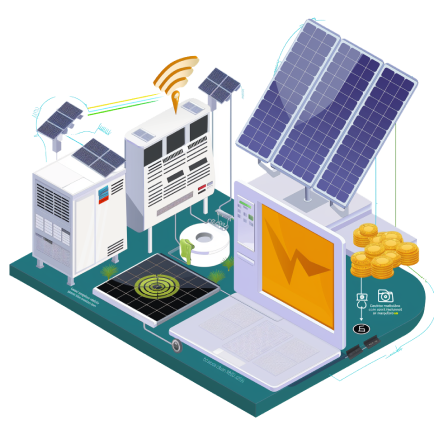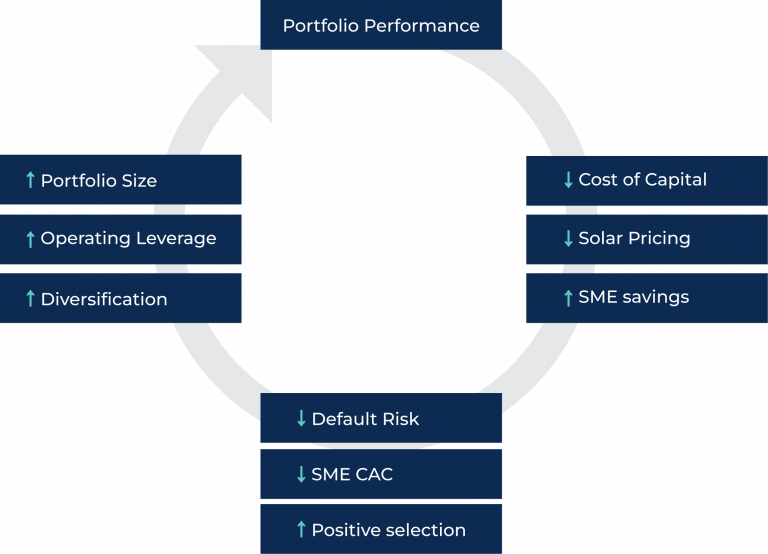
Build a portfolio in renewable energy, vetted by industry veterans and trusted by hundreds of investors

To crack problem at scale, this flywheel needs to spin…
Benefit from investing across geographies and asset types in the Developing World.

Renewable energy investments are annuity based. The cash flow is locked in over the length of PPA with break-even around 4-6 years depending on the length of the Power Purchase Agreement.
Renewable energy investments are annuity style investments. The cash flow is locked in typically over 7 to 20 years.

Why Renewable Energy Assets?
We help you diversify your asset allocation with private renewable energy assets to create a more efficient portfolio and improve your risk-adjusted returns.
Less Volatile

More Volatile
Benefits of Investing with Distributed Energy
Managed portfolio participants invest alongside institutional investors and DE executives who have jointly committed millions of dollars to date.
Target Net IRR for Selected Investments to Date
Average Length of Investment
Client Diversification Available
Impact Investing



We focus on investments in solar rooftop, which enables traditional industries to change their power source to clean energy.
We meet the criteria for multiple UN Sustainable Development Goals (SDGs) by helping investors invest in public goods.
We focus on investments in India, East Africa, and the Middle East, where access to capital for renewable energy is low.
Investment Options
Solar investments until now has only been available to large institutions. We want to make renewable energy a viable investment class for ALL investors by offering flexibility in making investment decisions.
Own the Plant Directly
You can invest in a solar plant directly. This is attractive if you want to leverage the depreciation benefits of the asset in the relevant jurisdiction or if the PPA customer is a related party.
Co-Invest in a HoldCo
Invest in a C&I focused managed HoldCo for renewable assets in India. Your equity will be valued at Net Present Value (NPV) and become part of a portfolio of investors. The risk is diversified and returns are based on existing customers and new assets.
Dedicated SPV
For investors committing $500,000 or more, we can create a dedicated Special Purpose Vehicle (SPV) for the investor. We manage the SPV as well as the customers end to end so there are no management overheads or challenges for the investor.
Alternate Investment Fund (AIF)
This is a unique opportunity to invest in India’s first Renewable Energy AIF with target 15% IRR to investor (pre-tax) over 10 years and have an impact in accelerating deployment of solar assets across commercial and industrial sectors. Minimum investment is ₹1Cr to participate.
* Through our banking relationships, depending on jurisdiction, portfolio size and bank structures, we can leverage your portfolios at attractive interest rates for all four structures, vastly improving your IRR.
Frequently Asked Questions?
The minimum investment requirement varies depending on the investment mandate expectations. For direct investments, the minimum investment requirement is $100,000. If you choose to invest in our managed portfolio, the minimum is $25,000. For investors committing $500,000 or more, Distributed Energy offers the option of creating a dedicated special purpose vehicle (SPV).
As an investor in one of our projects, you can expect 15%-25% annually, based on the leverage model and size of project. Distributed Energy targets projects with a minimum IRR of 15%. Further leverage normally enhances the IRR to 20% plus.
Distributed Energy signs Power Purchase Agreements that have a term length ranging between 7– 20 years. Depending on the length of the Power Purchase Agreement, there may be a balloon payment at the term end or a free of charge transfer to the customer.
Our income is tied to power generation i.e. performance of the plant. Distributed Energy charge fees of 5% (sweat equity) in the SPV and an annual fee of 15% as a Management Fee from the plant revenue. For investors, the minimum project IRR projection of 15% is after all our management fees have been factored in.
i) Product damage – using only Tier 1 rated panels, supplier warranty on panels/inverters (20+years) and additional product insurance secured by the SPV. There are force majeure insurances available that cover unexpected events.
ii) Production loss – tying up with world class EPC contractors and production guarantees backed by bank guarantees.
iii) Client default – all our customers go through a rigorous credit risk process and credit insurance is available in place against default. We also diversify the portfolios to spread risk and take 3-6 month bank guarantees from our customers. The cost of moving the panels is usually 10-15% of the total project value.
iv) Fluctuation in tariff – as per the contract between the SPV and the end-client, the tariff is a fixed, pre-decided absolute number and therefore government tariff does not impact our revenue.
Distributed Energy can build a portfolio of 4 assets for as little as $100,000 – you will be co-investing with Distributed Energy and other investors in these assets. Additionally, you will benefit from the following:
i) Automatic Diversification – benefit from investing across multiple energy customers in geographies varying from East Africa, the Middle East and India. You can focus your investment on geographies you feel comfortable with.
ii) Dependable Cash Flows – Distributed Energy targets investments in physical assets with strong, contracted cash flow profiles.
iii) Further Leverage Options – Once the capital is invested, through our banking relationships, Distributed Energy can leverage your portfolio 30:70 at attractive interest rates, vastly improving your IRR.
If the Customer chooses to exit the Power Purchase Agreement before the agreement term, a buyout clause will come into effect, which is detailed in the Power Purchase Agreement, on a year-on-year basis. The pre-determined residual value for each year will safeguard the targeted IRR of the project and ensure it is met.
All of the projects evaluated by Distributed Energy undergo a financial due diligence. Each project has its unique set of qualities, ranging from project size, location, type of customer, annual solar generation potential and depending on the location, a unique grid tariff rate. The IRR of a project is fundamentally influenced by the tariff rate (i.e. what is the discounted tariff rate we can offer), solar generation potential and the cost of the overall project. These parameters vary on a project to project basis, meaning some projects will have higher IRR potential compared to others being evaluated. At Distributed Energy, we target projects with an IRR potential of at least 16%.
All of our projects available for investment are screened on the basis of providing a project IRR of at least 16%. This means we are assuming 100% equity financing. Having said that, through our banking relationships, we can leverage (borrow from bank) an investor’s portfolio at attractive interest rates. When financing projects, the required amount of equity reduces (e.g. 50% of project value comes from investor and the balance 50% comes from the bank). Hence the return on equity (which is now half of the total project value) improves based on the bank interest rate payment. This is how the overall IRR improves.
Does all of the materials used in the installation of the solar plant have warranties and are they covered for the same period? Will replacement of materials, for example solar inverters, be the Investor’s responsibility?
Distributed Energy evaluates the financial viability of the project across two fronts:
1. Preliminary Investigation – The objective of the preliminary survey is to identify deal-breaking issues upfront before money and other valuable resources are committed to a detailed investigation. Some of the critical issues that may emerge during this exercise are concealment of facts and figures, core management succession, statutory non-compliance; industrial sickness (erosion of net worth); and legal proceedings.
2. Detailed financial due diligence:
Detailed company information;
Corporate solvency;
Directors, their interests and conflicts, if any;
Statutory compliance with the applicable regulations;
Taxation issues – income tax, customs, excise and sales tax;
Contractual liabilities and commitments;
Operating ratio analysis;
Optimal debt-equity structure
Receivable days average
Track record on making payments for electricity
References about the company from suppliers or customers, where possible.
Other relevant business or financial information available in the public domain.
As per the contract between Distributed Energy and the Customer, the tariff rate is a fixed pre-decided absolute number. Therefore, government tariff does not impact our ongoing revenue post agreement.
All our offers do not consider net metering for the Customer. If net metering is available that is a net benefit for the Customer that they can choose to avail. We size our plants for 70% of peak consumption to try and reduce any export of power. If gross metering comes in play at rates lower than ours, we can install reverse protection device to block any export of power to the grid.
Typically, evaluating project viability takes a few days. Once the term sheet and proposal are signed, the agreements are usually finalized within 1 to 2 weeks. Depending on the projects size, the entire process can take between 8 weeks and 8 months. Consequently, a plant generally becomes operational within 2 to 10 months of signing the Power Purchase Agreement.
Solar systems require a reference voltage to operate. This reference power can be obtained from the grid, a battery, or a generator. Without being connected to the grid, a battery, or a generator, solar systems cannot function.
If we sign an operating lease, the customer will pay for the lease independently of power generation or consumption.
Save 15% or more. Don’t over pay on your electricity. Switch to solar with minimum hassle. You only pay us when you save money!
Company